16.03.2007
I.SMIKOVSKY. A PORTRAIT OF A CHESSPLAYER - VLADIMIR KRAMNIK (PART III)
In 1992 in Paris a rapid chess knockout tournament with participation of the best players of the world headed by world champion Garry Kasparov took place. There were no sensations – the rating favorite won the tournament. In the first round he had narrowly won a two-game micro-match against 17-years-old Vladimir Kramnik. This was the beginning of those two players' opposition. Certainly, in comparison with battles Kasparov – Karpov (the opponents have played 5 matches against each other), the Kasparov-Kramnik competition does not look so bitter, but, in my opinion, the struggle against the 13th world champion is a special subject in Kramnik's creative work worth of a special chapter. By the way, in their first game played in Paris Kramnik had achieved a significant advantage in Gruenfeld Defense, but failed to convert it into a win. The game was a draw. The main thing is that Vladimir was ready to win against Kasparov; his time just hadn't come yet. And how many splendid players and even chess geniuses just could not play against Kasparov and had an indifferent (to put it mildly) statistics in their games against him? Psychological factor plays a decisive role here, and Vladimir Kramnik since their very first game has never yielded the psychological initiative. His games against Kasparov were going on with varied success, and not one of the players managed to take the obvious lead. Somewhere in the mid-nineties the feeling had come, that it was exactly Kramnik who was equal to the task of beating Kasparov in a long match. I suggest that in the final chapter of our essay we recall the most significant and interesting duels between Vladimir Kramnik and Garry Kasparov. The first Kramnik's win against Kasparov took place during the famous Spanish super tournament. Kramnik – Kasparov E93 1.¤f3 ¤f6 2.c4 g6 3.¤c3 Ґg7 4.e4 d6 5.d4 O-O 6.Ґe2 e5 7.d5. Petrosian variation was a principal Kramnik's weapon against King's Indian Defense at that time. Later he had switched over to the variation 7.0-0 ¤c6 8.d5 ¤e7 9.b4 and won a lot of memorable games in it. But let us not get ahead of ourselves. 7...¤bd7. More reliable seems 7...a5 with subsequent knight's development to a6. 8.Ґg5 h6 9.Ґh4 g5 10.Ґg3 ¤h5 11.h4 g4 12.¤h2 ¤xg3 13.fxg3 h5 14.O-O This position has been long known in theory. Black has managed to spoil white pawn structure slightly, to get a pair of bishops and therefore a possibility to play along dark squares. But opening up of the f-line has made the f7-pawn lag in advance, and White intends to strengthen his control over the f5-square: the bishop will go to d3, the h2-knight will become alive again jumping to e3 via f1. Then he can begin advancing his Q-side pawns. Such had been the scenario of some previously played games, and so the well-established opinion had it that the white chances were better. So what did Garry Kasparov have in mind? 14...f5!? Black offers a pawn, although he will win it back in time. At the same time it should be kept in mind that the inevitable opening up of the game will not only further the black bishops' enlivening, but also disturb the black king's calm. 15.exf5 ¤c5 16.b4. On 16.Јc2 or 16.Ґd3 there would follow 16...e4! 16...e4!? True to himself, Kasparov chooses the most principled continuation. In case of 16...¤a6 17.¦b1 Ґxf5 18.Ґd3 White has a slight edge. 17.¦c1 ¤d3 18.Ґxd3 exd3 19.f6! Strictly the only move. After self-suggesting 19.Јxd3 Јf6 Black will take on f5 with his bishop and get an advantage. Kramnik immediately returns the offered pawn in order to prevent the active position of his opponent's pieces. 19...¦xf6 20.Јxd3 Јf8. Renewing the possibility of bishop's development to f5. 21.¤b5!? Vladimir ventures upon a positional sacrifice of exchange. He could also choose 21.¤e4 ¦xf1+ 22.¦xf1 (if 22.¤xf1 Ґf5 23.¤e3, then not 23...Ґg6? 24.¦f1 Јe7 25.¤f5±, but 23...Ґxe4!24.Јxe4 ¦e8=) 22...Ґf5 23.¤f6+ (23.Јd2 ¦e8 24.Јg5 ¦xe4 25.Јxh5 ¦xc4 does not promise anything pleasant) 23...Јxf6 24.Јxf5 Јxf5 25.¦xf5 Ґd4+ 26.ўf1 ¦f8 27.¦xf8+ ўxf8, but to convert such an extra pawn into a win is hardly possible. 21...Ґf5 22.¦xf5! ¦xf5 23.¤xc7 ¦c8 24.¤e6 Јf6 A strong e6-knight and a prospective passed pawn in the center guarantee an adequate compensation to White, but one should not overestimate his position. 25.¤f1. An exchange of active f5-rook is good for White, but in case of 28.¦f1 there follows a surprising 28...¦f8! 29.¤xf8 Јd4+ 30.Јxd4 Ґxd4+ 31.ўh1 ¦xf1+ 32.¤xf1 ўxf8= – White is two pawns up, but it is impossible to win an endgame without king's participation. 25...¦e5 26.¦d1! The necessary prophylactics. Straightforward 26.c5?! hits on 26...¦xe6! 27.dxe6 Јd4+ 28.Јxd4 Ґxd4+ 29.ўh2 dxc5, and White is only one who can face problems here. Nothing would come out of 26.¤d2 Јf5 27.Јxf5 ¦xf5 with a threat of 28...¦xd5 either. 26...Јf5! For the sake of his king's security Black has to exchange the queens. 27.Јxf5 ¦xf5 28.c5 Ґf8. Losingis 28...dxc5? 29.d6ќ, and if 28...Ґe5, then 29.¤e3 ¦f7 30.ўh2 with subsequent 31.¤c4. 29.¤e3 ¦f6 30.¤c4 dxc5 31.b5! White has managed to stabilize the situation on the Q-side and is ready to begin his operations on the K-side; his aim is the weak h5-pawn. 31...Ґh6? Carelessly leaving the d6-square undefended. Black should play 31...¦e8! with a threat of taking on e6. Then it is possible to move 32.¤f4 (in case of 32.¦e1 ¦f5 the rook has to be given back) 32...¦e4 (also worth attention is 32...Ґd6!? 33.¤xh5 ¦h6) 33.d6 ¦fxf4! (in the variation 33...¦xc4 34.d7 Ґe7 35.¤d5 Ґd8 36.¤xf6+ Ґxf6 37.d8=Ј+ Ґxd8 38.¦xd8+ ўf7 39.¦d7+ ўe6 40.¦xb7 ¦a4 41.¦h7 White retains chances to win) 34.gxf4 ¦xc4 35.d7 Ґe7 36.d8=Ј+ Ґxd8 37.¦xd8+ ўf7 38.ўh2! (38.¦d7+? ўe6 39.¦xb7 g3!µ) 38...¦xf4 39.¦d7+ ўe6 40.¦xb7 ¦a4 41.¦h7 ¦xa2 42.¦xh5=. 32.¦e1! ¦e8. Now 32...¦f5? is impossible in view of 33.¤d6ќ. 33.¦e5. Also interesting is 33.ўh2!? with a threat of 34.d6. 33...¦e7 34.¦xh5 ¦ef7. Black's last hope is an attack along the first rank. 35.ўh2 Ґc1 36.¦e5 ¦f1 37.¦e4 ¦d1 38.¦xg4+ 38...ўh7? A decisive mistake. Stronger is 38...ўh8 39.¦e4 ¦xd5 (harmless is 39...¦ff1 40.ўh3) 40.¤e5 ¦f6 41.¤f3. White advantage is indubitable, but Black can still hope for counterplay due to his passed c-pawn. 39.¤e5! ¦e7. On 39...¦ff1 the issue is decided by 40.¦g7+ ўh6 41.¤g4+ ўh5 42.¤f6+! ¦xf6 (42...ўh6 43.¤g8+ ўh5 44.g4+ ўxh4 45.g3#) 43.g4+ ўh6 44.g5+. 40.¤f8+. Black resigned in view of 40...ўh6 41.¦g6+ ўh5 42.g4+ ўxh4 43.g3#. 1-0 The theoretical King's Indian discussion was soon to be continued during one of the rapid chess Grand Prix rounds, Vladimir being the first to turn off the beaten track. Kramnik – KasparovE93 1.¤f3 ¤f6 2.c4 g6 3.¤c3 Ґg7 4.e4 d6 5.d4 O-O 6.Ґe2 e5 7.d5 ¤bd7 8.Ґe3. Kramnik directs the struggle into another groove. 8...¤g4. Preventing White's playing 9.¤d2, which would have given him a comfortable advantage. 9.Ґg5 f6 10.Ґh4 h5 11.¤d2 ¤h6 12.f3 ¤f7 13.Јc2 Ґh6 14.O-O-O!? Taking into account the weakened black Q-side Vladimir chooses an ambitious plan. He sends his king on another flank and shows his readiness for a complex game with mutual chances. 14...c5 15.dxc6?! Objectively speaking this is not the best decision. More preferable is 15.ўb1 retaining a slight edge. 15...bxc6 16.ўb1 a5?! After the pawn exchange in the center the c4-c5 advance is on the agenda. Black could play c6-c5 himself; after that there appear mutually weak squares d4 and d5 – the positional estimate will depend on which side would take better advantage of this. Now Kasparov should have played 16...¤c5! 17.¤b3 (17.Ґf2 ¤e6 18.¤b3 Јe7 with an idea of c6-c5) 17...Ґe3 with good counterplay. 17.¤a4! c5 18.¤c3 Ґe3? Black transfers his bishop to d4 but loses the principal king's defender, and that leads to a difficult position. 18...Ґb7 19.¤d5 a4 leads to an unclear play. 19.¤d5 Ґd4 20.¤b3 Ґb7 21.¤xd4 cxd4 22.f4! The f6-pawn is weak; Black has serious problems. 22...¦b8?! Not an obligatory move. It is time to switch over to the defense: 22...¤h6 23.fxe5 dxe5 24.c5 with white initiative. 23.¦hf1 ¤h6 24.c5!? A daring intuitive decision implying subsequent offers. Probably the simple 24.fxe5 dxe5 25.c5 is stronger, but Kramnik opts for more. 24...Ґxd5 25.exd5 ¤f5 26.fxe5! ¤xh4. In case of 26...¤xe5 27.¦xf5 gxf5 28.c6 Јb6 29.Ґf2 Black's in a really bad way. 27.exd6 ¤e5 28.¦xd4. Central pawns' avalanche is undoubtedly worth of a piece offered, but Vladimir is ready to part even with a rook. 28...¤f5. If 28...¦b4, then 29.¦xb4 axb4 30.Јe4 ¤f5 31.Јxb4. 29.¦xf5! gxf5 30.Јxf5. Now Black has two weaknesses – the highly dangerous white pawns and the insufficiently defendedking. His chance for salvation is counterattack. 30...ўg7. To defend such a position is extremely difficult, especially when playing rapid chess. For example, after 30...¦b4 31.Јe6+ ўh8 (to a difficult position leads 31...ўg7 32.¦xb4 axb4 33.Јe7+ ўg6 34.Јxd8 ¦xd8 35.c6 ¤xc6 36.dxc6 ¦xd6 37.Ґf3 ¦d4 38.a4 bxa3 39.b3!ќor 33... ¤f7 34.Ґxh5 Јa8 35.Ґxf7 ¦xf7 36.Јe4 ќ; there are no practical chances as well in 31...¤f7 32.¦xb4 axb4 33.Ґxh5 ўg7 34.Ґxf7 ¦xf7 35.c6 Јb6 36.c7 Јg1+ 37.ўc2 Јxg2+ 38.ўb3 – the king escapes checks) 32.¦xb4 axb4 33.Јe7! (33.Ґd1 Јa5) 33...Јc8 (if 33...Јa8 34.d7 ўg8, then 35.Ґd1! – now neither 35...Јxd5 36.Ґb3 ¤c4 37.Ґxc4 Јxc4 38.Јxf8+ ўxf8 39.d8Ј+ќ nor 35...¤f7 36.Јxf6 Јxd5 37.Ґc2 ¤e5 38.Ґb3ќ can save Black) 34.d7! ¤xd7 35.Ґd3 f5 36.c6 ¤b6 (36...¤f6 37.d6ќ) 37.Јc5! ¤xd5 (37...¤a8 38.d6ќ) 38.Јxd5 ¦f6 39.Ґb5± White has excellent chances to win. 31.Ґxh5 31...¦h8? A decisive mistake. Kasparov has overlooked White's next move; it is already necessary to play 31...¦b4! After 32.¦d2! (incaseof32.¦xb4 axb4 33.Јe6 Јa5! White has nothing better than a perpetual check: 34.Јe7+ ўg8 35.Јe6+ ўg7=) Black should be extremely accurate, bad is 32...¤c4? 33.Јg6+ ўh8 34.¦d3! ¦xb2+ 35.ўa1 ¦b7 36.¦h3 ¦h7 37.Ґg4 ¦xh3 38.Ґxh3 f5 (38...¤e5 39.Јh6+ ўg8 40.Ґe6+ ¦f7 41.d7ќ) 39.Јh6+ ўg8 40.Ґxf5ќand 32...¦h8 33.¦e2! (with a threat of 34.¦xe5) 33...¦h4 34.g4ќ. More interesting is 32...Јb8!? 33.d7 (33.a3 ¦c4 34.¦c2 Јb3 35.c6 ¦xc2 36.Јxc2 Јxd5 37.c7 Јe6›; 33.¦c2 ¦h4 34.g4 Јb4›) 33...¦h4 34.a3!?, although White's play is easier in this variation. And the best way seems to be 32...Јc8!, which after 33.Јxc8 ¦xc8 34.c6 ¤c4! 35.d7 ¤xd2+ 36.ўc2 ¦a8 37.ўxd2 ¦d4+ 38.ўe3 ¦xd5› leads to a somewhat crazy ending. 32.¦g4+! It is all over now. 32...ўf8 (32...¤xg4? 33.Јg6+ ўf8 34.Јf7#) 33.Јe6! Black pieces are paralyzed. 33...¦b7 34.c6 ¦xb2+.The last hope for a perpetual check turns out to be wishful thinking – white king finds a shelter. 35.ўxb2 Јb6+ 36.ўa3! Јc5+ 37.ўa4 Јc2+ 38.ўb5 Јb2+ 39.ўa6 Јe2+ 40.ўb7 ¦h7+ 41.d7 1-0 To win against Garry Kasparov playing with Black is next to a miracle. In the games with classic time control Kramnik managed to do this only once. The victory was extraordinarily brilliant and spectacular. Kasparov – Kramnik D47 1.d4 d5 2.c4 c6 3.¤c3 ¤f6 4.¤f3 e6 5.e3 ¤bd7 6.Ґd3 dxc4 7.Ґxc4 b5 8.Ґd3 Ґb7 9.O-Oa6 10.e4 c5 11.d5 c4 12.Ґc2 Јc7 The opponents played one of the actual branches of Meran variation in Slav Defense. Theoretical discussion in that position continues even now. White tends to choose 13.dxe6 fxe6 14.¤g5, but Garry Kasparov has other plans. 13.¤d4 ¤c5 14.b4! This leads to a lively and substantial play. White reckons to take advantage of black king's delay in the center. However White has no particular alternative already – 14.dxe6?! fxe6 with subsequent Q-side castling is for Black's benefit. 14...cxb3 15.axb3 b4! Kramnik takes up the gauntlet. 16.¤a4 ¤cxe4! 17.Ґxe4!? Quite an unexpected novelty. By all appearances, why should White exchange his bishop for a knight? The idea of this preliminary exchange will become clear a little later. In Yakovich – Sorokin (Calcutta 1991) there occurred natural 17.dxe6 ¦d8! 18.exf7+ (if 18.Ґxe4, then 18...Ґxe4!) 18...ўxf7 19.Ґe3 Ґd6 20.h3 ¦he8, and Black acquired good play. 17...¤xe4 18.dxe6 Ґd6! Now on 18...¦d8 there will follow 19.Ґb2!, and then, for instance, 19...Јf4 (no good is also 19...Ґd6?! because of 20.¦c1! Ґxh2+ 21.ўh1 Јf4 22.exf7+, and Black cannot take the pawn with his king in view of a check from h5; dangerous as well is 19...¤c3 20.Ґxc3 bxc3 21.Јg4) 20.Јe2 Ґd6 21.g3 Јg5 22.f3 with white initiative. 19.exf7+ 19...Јxf7!? Kramnik does not wish to yield the initiative and is prepared to sacrifice a piece. In case of 19...ўxf7 20.Јh5+ g6 21.Јh3 black king gets weakened, but the position is hard to estimate – it is possible to continue 21...¦ae8!? and 21...Јc8!?. 20.f3 Јh5! And this is the only move. On any knight's retreat the rook gives check from e1; unsatisfactory as well is 20...O-O? 21.fxe4 Јxf1+ 22.Јxf1 Ґxh2+ 23.ўxh2 ¦xf1 24.¤c5ќ. 21.g3. Kasparov is surely not happy with a faint-hearted 21.h3?! Јe5 22.f4 (22.fxe4? Јh2+ 23.ўf2 O-O+ 24.¤f3 Ґxe4°) 22...Јf6і. 21...O-O?! It is clear that the knight has to be sacrificed, but to determine the most precise version at the board is very difficult. Perhaps, stronger is 21...¤xg3! 22.hxg3 O-O, and in case of the correct answer 23.¦a2! Ґxg3 24.¦g2 Ґe5 25.¤c5 ¦ad8 26.Ґe3 Ґc8 27.f4! Јxd1 28.¦xd1 Ґxf4 29.Ґxf4 ¦xf4 30.¦gd2 the game would most probably end in a draw. 22.fxe4 Јh3! Black keeps on stepping up his pressure with enviable composure. Much weaker is forced 22...¦xf1+ 23.Јxf1 Ґxg3 24.hxg3 Ґxe4 25.¦a2 Јh1+ 26.ўf2 Јh2+ 27.ўe3 Јxa2 28.ўxe4± 23.¤f3? It looks like White has underestimated his opponent's attack. It suggests itself to include the rook into defensive actions by way of 23.¦a2. Then it is possible to play 23...Ґxe4 (23...Ґxg3? 24.¤f5 ¦xf5 25.¦xf5 Ґxe4 26.¦g5!ќ) 24.¦e1! (or else the blow on g3 will follow) 24...Ґb7 (24...¦ae8 25.¦e3) 25.Јd3 – White has parried the direct threats. But still stronger is 23.Јe2! Ґxg3 24.¤f5! (during the game both opponents have overlooked this move) 24...Ґe5 (24...¦xf5 25.¦xf5 Ґxh2+ 26.Јxh2 Јg4+ 27.ўf2 Јxe4 28.Јe5ќ) 25.Ґb2±, and an extra piece should tell. 23...Ґxg3! 24.¤c5? A second mistake in a row. Surely White should not play 24.hxg3? Јxg3+ 25.ўh1 Ґxe4°, but after 24.Јe2! ¦xf3 25.¦xf3 Ґxh2+ 26.ўf2 (26.ўh1? Ґxe4! 27.Јxe4 Ґg3+ 28.ўg1 Јh2+ 29.ўf1 Јh1+ 30.ўe2 Јe1+ 31.ўd3 ¦d8+°) 26...Јh4+ 27.ўf1 there is nothing decisive for Black: 27...Ґe5 (27...Ґxe4 28.Јc4+ ўh8 29.¤c5; 27...Ґg3 28.Јg2!) 28.Јc4+ ўh8 29.Јxb4 Јh1+ 30.ўe2 Јg2+ 31.¦f2 Јg4+ 32.ўe1 Јg1+ 33.ўe2 Јg4+=. 24...¦xf3 25.¦xf3?! More stubborn is 25.¦a2 ¦xf1+ 26.Јxf1 Јxf1+ 27.ўxf1 ¦c8! 28.Ґe3 Ґf4! 29.¤xb7 Ґxe3 30.¦xa6, although Black obviously has a large edge. 25...Јxh2+ 26.ўf1 26...Ґc6! Black light-squared bishop decides the issue. White has an extra rook, but still he is absolutely helpless. 27.Ґg5. Any other move is none the better: 27.Јd3 Јh1+ 28.ўe2 Јe1#; 27.¦a2 Ґb5+ 28.¤d3 Ґxd3+ 29.¦xd3 ¦f8+ 30.¦f3 Јh1+°;27.¦a5 Ґc7!°. 27...Ґb5+ 28.¤d3 ¦e8! Every black piece is "wide awake", they all take part in the attack. 29.¦a2 (29.¦c1 Јh1+ 30.ўe2 ¦xe4+ 31.ўd2 Јg2+) 29...Јh1+. The mate could be given more rapidly by way of 29...Ґxd3+ 30.¦xd3 Јh1+ 31.ўe2 Јg2+ 32.ўe3 ¦xe4#, but this is already not so important. 30.ўe2 ¦xe4+ 31.ўd2 (31.Ґe3 Јg2+ 32.¦f2 Јxf2#) 31...Јg2+ 32.ўc1 Јxa2 33.¦xg3 Јa1+ 34.ўc2 Јc3+ 35.ўb1 ¦d4. White resigned not waiting for 36.Ґf6 Ґxd3+ 37.ўa2 Ґb1+! 38.Јxb1 ¦d2+. 0-1 And now let us look back and interpret what we have seen. In my opinion all the games are somewhat similar. At some instant one of the opponents (Kramnik) used to have a greater wish to gain the initiative (exactly the initiative, not an advantage – we should not mix up those notions!), being prepared even to offer some material for that. The other side (Kasparov) had as a result to defend himself, "to play the second fiddle", and thus to put the lid on his own desires. Hence is irresolute play, mistakes in objectively normal positions and defeats. I by no means lay claim to deep conclusions, I just express the opinion that in the games Vladimir Kramnik has won against Garry Kasparov he usually managed to impose on his opponent the "uncomfortable" for the latter kind of play. Vladimir used to make the most of his universality. By contrast there is quite another kind of victory. Once again Kasparov persists in his favorite opening and employs an interesting novelty sacrificing the pawn for the initiative... Kramnik – Kasparov E97 1.¤f3 ¤f6 2.c4 g6 3.¤c3 Ґg7 4.e4 d6 5.d4 O-O 6.Ґe2 e5 7.O-O ¤c6 8.d5 ¤e7 9.b4! Taimanov's recommendation which had been long known in theory but became popular only during the 1990th. Due to Vladimir Kramnik's victories this continuation has become a principal means of playing against King's Indian Defense. 9...¤h5 10.¦e1 ¤f4 11.Ґf1 a5 12.bxa5 ¦xa5 13.¤d2 c5 14.a4 ¦a6 15.¦a3! "It is a beginning of a plan that appears the strongest in the given position, which has been proved by further chess practice. White intends to put his knight on b5, his bishop on b2, play g2-g3 and, so far as Black's counterplay will be hampered by his knight being situated on h5, to gradually prepare the f2-f4 advance, driving the knight away from h5 with Ґf1-e2. Meanwhile White also has an opportunity to increase the pressure along the dark-colored long diagonal with the "ambush" maneuver Јd1-a1" (Kramnik). It is important that Black cannot play 15...f5? in view of 16.g3 ¤h5 17.exf5. 15...g5!? Kasparov employs a new interesting idea connected with a pawn sacrifice. 16.g3. A principled reply. Kramnik wins a pawn, although 16.¤b5!? is also worth attention. 16...¤h3+ 17.Ґxh3 Ґxh3 18.Јh5 Јd7. In White's favor is 18...g4? 19.¤f3 f6 (19...gxf3 20.Јxh3 f5 21.Јh5±) 20.¤h4±. 19.Јxg5. The tempting 19.f3 with an idea of catching the bishop would give nothing because of 19...g4 20.¤d1 f5!›. 19...h6 20.Јe3 f5. Black manages to foil his opponent's plans and get a serious initiative for his pawn. 21.Јe2! Less strong is 21.f3?! f4 – third rank would come in handy for a rook. 21...f4. If 21...fxe4 22.¤dxe4 ¤f5, then 23.¤b5 ¤d4 24.¤xd4 exd4 25.Јh5 Ґg4 26.Јh4І. 22.¤b5 ўh7? A barely noticeable mistake which is to seal Black's fate. White is given an opportunity to take on f4, after which in many variations the unfortunate king's position on h7 will tell. To a complex play leads 22...ўh8 or 22...¤g6!? 23.ўh1 ўh7, and if 24.¦g1?!, then 24...f3! 25.¤xf3 Ґg4 with a threat of 26...¦xa4. 23.gxf4! exf4. On 23...¦xf4?! there would follow 24.¦g3, not being concerned about 24...¦xa4 because of 25.¤xd6! 24.ўh1 Ґg4! Otherwise after 25.¦g1 Black would have problems with light-squared bishop. 25.¤f3! Without any prejudices at all. The knight gets under a pin on its own free will, but Vladimir has taken into account the fact that Black would not have time to take advantage of it. In case of 25.f3? Ґh5 Black has strong initiative. 25...¤g6 26.¦g1 Ґxf3+? Missing his chance to escape once and for all; nevertheless to find an adequate defense against the threat of 27.¤g5+ is not simple. Losing is 26...¤e5? 27.¤xe5ќ, to a difficult ending leads 26...¤h4 27.¤g5+ hxg5 28.Јxg4 Јxg4 29.¦xg4±, and on 26...ўh8 White should play not 27.Ґb2 Ґxb2! (27...¤h4? 28.Ґxg7+ Јxg7 29.h3! Ґxf3+ 30.¦xf3±) 28.Јxb2+ ўh7›, but 27.¤c7! ¦b6 (27...Јxc7 28.¦xg4±) 28.h3! Ґxh3 (28...Ґh5 29.¤e6 ¦f7 30.Јc2±; 28...Јxc7 29.¦xg4±; 28...Ґxf3+ 29.¦xf3±) 29.¦xg6 Јxc7 30.¤h4! Ґd7 31.¦g1± with dangerous threats. A prophylactic 26...¦e8 does not solve problems either in view of 27.h3! (27.¤g5+ hxg5 28.¦xg4 ¦xe4!›) 27...Ґxf3+ (27...Ґxh3 28.¤g5+ hxg5 29.Јh5+ ўg8 30.¦xh3 ¦e5 31.Ґb2ќ) 28.Јxf3±. 27.Јxf3 ¤e5 28.Јh5 Јf7. 28...¤xc4 29.Јg6+ ўh8 30.¦h3ќ. 29.Јh3! Now White attacks having an extra pawn. He now plans 30.Ґb2, and on 29...¦g8 there is a highly unpleasant answer 30.Јe6! 29...¤xc4 30.¦f3 Ґe5. 30...Јe7 31.Јe6! Јxe6 32.dxe6 ¦xa4 33.¤c7 Ґf6 34.¦xf4 does not leave any chance for an escape. The move made during the game permits a spectacular tactical blow. 31.¤c7! ¦xa4 (31...Јxc7 32.Јxh6+ ўxh6 33.¦h3#) 32.Ґxf4!Black resigned, as on 32...Ґxf4 the issue is decided by 33.¤e6 ¦g8 34.¦xg8 Јxg8 35.Јf5+ ўh8 36.Јf6+ ўh7 37.¤f8+. 1-0 I hope the reader wouldn't get a wrong impression that Kramnik has been constantly, time after time defeating his formidable opponent. They are approximately equal in their confrontations, and most of the games have naturally ended in draws. Their next game had been played shortly before their world championship match. It may well be an answer to a question of what a real GM draw is. Kramnik – Kasparov A30 1.¤f3 ¤f6 2.c4 c5 3.g3 d5 4.d4 dxc4 5.Јa4+ Ґd7 6.Јxc4 Ґc6 7.dxc5 Ґd5 8.Јa4+ Ґc6 9.Јc4 Ґd5 10.Јc2 e6 11.Ґg2 Ґe4 12.Јc4 Ґd5 13.Јh4 Ґxc5 14.¤c3 Ґc6 15.O-O Ґe7 16.¦d1 Јa5 17.Ґd2 ¤bd7 There were lots of subtleties and nuances on the opening stage, but I won't comment on it as the most interesting things begin right now. Black has only to castle in order to complete development and to level the play but it is White who is to move, and Vladimir Kramnik does not wish to yield the initiative. 18.g4! h6. Dangerous is 18...O-O 19.g5 ¤e8 (19...¤d5? 20.¤xd5 Јxd5 21.Ґb4ќ) 20.¤e4 Јa4 21.Ґc3!? It does not help to get rid of problems to play 18...Јb4 19.g5 Јxh4 20.¤xh4 ¤g4 21.Ґxc6 bxc6 22.¤f3 either. After 18...h6 the h7-square is free for the knight. 19.Јg3 Јa6 20.h4 Јc4. Despite the suspicious position of the black knight the variation 20...h5!? 21.g5 ¤g4 still deserves attention. 21.Ґf4 (threatens 22.¦d4) 21...Јb4. In case of 21...g5 22.hxg5 hxg5 White is not obliged to play 23.¤xg5 e5! but can keep the pressure by way of 23.Ґe5І. 22.a3! There begins a tough game, demanding highest accuracy, in which Kasparov manages with the only moves to hold his precarious position. 22...Јxb2 23.¤d4! Black queen feels uncomfortable, and White already creates threats to the c6-square. 23...g5.Neither 23...Ґxg2 24.¦db1! ¤e4 25.¦xb2 ¤xg3 26.ўxg2 e5 (26...¦c8 27.Ґxg3 ¦xc3 28.¦xb7±) 27.Ґxg3 exd4 28.¤d5±, nor 23...Јb6 24.¦ab1 Јa6 25.¤cb5± solves the problems. 24.¤xc6!? Vladimir chooses the most principled way, but maybe it's been worth it to decide in favor of modest 24.hxg5 hxg5 25.Ґxg5 Ґxg2 26.ўxg2 (26.¦db1? Ґe4°) 26...Јb6 27.¦ab1 Јc5 28.Ґxf6 Ґxf6 29.¦b5±. Bad king wouldn't give Black a moment's peace. 24...gxf4 25.Јd3 bxc6 26.Ґxc6. On 26.¦db1 there is an escape 26...¤e5! 26...O-O 27.Ґxa8 ¤e5! After 27...¦xa8 28.¦db1 ¤e5 29.¦xb2 ¤xd3 30.exd3 ¤xg4І Black is down an exchange, but he still has good chances for a draw, as White's pawn structure is destroyed. Kasparov plays even more precisely, enticing white queen under a pin. 28.Јd4 ¦xa8 29.Јxe5. In the variation 29.¦ab1 Јxe2! 30.¤xe2 ¤f3+ 31.ўh1 (31.ўg2 ¤xd4 32.¦xd4 e5 33.¦a4 ¤xg4) 31...¤xd4 32.¦xd4 f3 33.¤g1 Ґxa3 Black never runs into troubles. 29...¦c8 30.¦ac1. 30.¦dc1?! ¤d5 31.¦ab1 Јxa3і. 30...¤d5! Vladimir has underestimated this personal resource "from afar". Kasparov gives up all his residuary material for the queen, but it turns out to be not enough for White to win. Much weaker is 30...¦c5? 31.Јd4 Јxa3 (31...¤xg4 32.Јb4) 32.f3±, and White should convert his extra exchange into a victory. 31.¤xd5 Јxe5 32.¤xe7+ ўg7 (32...ўh7!? 33.¤xc8 Јxe2 34.¤d6 Јxg4+ 35.ўf1 f3 36.¤xf7 Јxh4 37.ўe1 Јe4+=) 33.¦xc8!Here it is White's turn to watch out: 33.¤xc8?! Јxe2і. 33...Јxe2 34.¦g8+ ўf6 35.¦d7 35...Јe1+! The only move again. Erroneous is 35...f3? (this square has to be left free for the queen) 36.g5+ ўe5 (36...hxg5 37.¦xg5! Јe1+ 38.ўh2 Јxf2+ 39.ўh3 e5 40.¤f5! e4 41.¤d4! Јf1+ 42.ўg4 Јg2+ 43.ўh5 Јh3 44.¦d6+ ўe7 45.¤f5+ Јxf5 46.¦xf5 ўxd6 47.ўg4ќ) 37.gxh6 Јe1+ 38.ўh2 Јxf2+ 39.ўh3 Јf1+ 40.ўg4 f2 41.h7 Јe2+ 42.ўg5 f1Ј (42...Јe3+ 43.ўh5 Јf3+ 44.¦g4ќ) 43.h8Ј+ f6+ 44.ўh6ќ, and in this fantastic position even two queens cannot save Black! 36.ўg2 Јe4+ 37.ўh2 Јc2 38.ўg2 Јe4+ 39.ўh2 Јc2 40.g5+ hxg5 41.¦xg5. Or 41.hxg5+ ўe5 42.ўg2 Јe4+=. 41...Јxf2+ Ѕ-Ѕ And here at last we are coming close to the face-off on the highest level. Undoubtedly, there are reasons for which Kasparov has failed to reveal his best qualities during this match, but the fact that Kramnik has won deservedly is hard to dispute. He had shown his defensive super-reliability and impregnability and managed to make the most of his "scoring chances". To a considerable degree this was due to his brilliant opening preparation – the aspect in which nobody seemed ever to excel Garry Kasparov before. Vladimir managed to open the score as early as in the second game. Kramnik – Kasparov D85 1.d4 ¤f6 2.c4 g6 3.¤c3 d5. Kasparov had seriously counted on Gruenfeld Defense in the London match, but his patented opening "cracked" during his very first game with black pieces. 4.cxd5 ¤xd5 5.e4 ¤xc3 6.bxc3 Ґg7 7.¤f3 c5 8.Ґe3 Јa5 9.Јd2 Ґg4. 9...¤c6 occurs more often, but in this variation Black has his problems – undoubtedly, Vladimir has been well-prepared for the main continuation. 10.¦b1 a6 11.¦xb7!This natural capture is in truth an important strengthening that has made Kasparov change the opening. There appear positions of a kind in which Black has to "keep his patience" for a long time without any chance for an active play. 11...Ґxf3 12.gxf3 ¤c6. There is a deceptive impression that Black assuredly wins back a pawn and levels the position. 13.Ґc4! O-O. There is no leveling after 13...cxd4 14.cxd4 Јxd2+ 15.ўxd2 ¤xd4 16.¦hb1! ¤xf3+ 17.ўe2 ¤d4+ 18.ўf1І as well. 14.O-O cxd4. In case of 14...¦ad8 15.d5 Ґxc3 16.Јe2± the vulnerability of the e7-pawn begins to tell. Black is practically forced to transfer the game into an unpleasant ending. 15.cxd4 Ґxd4. 15...Јh5 16.Ґd5!± is inadequate – Black has nothing. It is also possible to choose 15...Јxd2 16.Ґxd2 ¤xd4, but then 17.ўg2 e6 18.¦c1, and the pair of bishops guarantees long-lasting initiative to White. 16.Ґd5! It is noticeable even here that Black is in trouble. 16...Ґc3. Black cannot hold the position after 16...Ґxe3? 17.Јxe3 ¦ac8 (17...¤b4 18.Јc3 e6 19.Ґxe6!ќ) 18.¦c1 ¤b4 19.¦xc8 ¦xc8 20.Јd2 e6 21.Ґxe6! fxe6 22.Јh6ќ, and in case of 16...Јxd2 17.Ґxd2 ¤e5 (17...¦fc8 18.¦c1І) 18.Ґh6 e6! (18...¤xf3+ 19.ўg2 ¤h4+ 20.ўh3±; 18...¦fe8 19.¦xe7 ¦xe7 20.Ґxa8 ¤xf3+ 21.ўg2±) 19.Ґxf8 exd5 20.f4 ¤f3+ 21.ўg2 dxe4 22.Ґa3Іhe faces difficult struggle for a draw, so that is probably just the way to play. 17.Јc1! A precise move. White aims at the opponent's minor pieces. 17...¤d4. On 17...¦ac8 there is 18.Ґb6! Јb4 (18...¤d4? 19.Јd1 Јb4 20.a3 Јd6 21.Ґxd4 Ґxd4 22.Јxd4 e6 23.Јf6ќ won't do) 19.a3 Јb2 20.Јxb2 Ґxb2 21.a4± with an advantage in the ending. Kasparov prefers to cede a pawn and to transpose the game into an ending with opposite coloured bishops. 18.Ґxd4. Less strong is 18.Јd1? because of 18...e6! 18...Ґxd4 19.¦xe7. White's considerable chances to win are determined by predominating position of the d5-bishop together with the weakness of the f7-square. 19...¦a7 20.¦xa7 Ґxa7 21.f4! An unobvious decision. Kramnik transfers his pawns to the dark squares in order to prevent the pressure along the b8-h2 diagonal. This is more important now than the control over the d5-square. 21...Јd8 22.Јc3 Ґb8.If 22...Јh4, then 23.Јg3 with a rough variation 23...Јxg3+ 24.hxg3 ¦b8 25.Ґb3 ¦d8 26.e5 ¦d2 27.ўg2 ўg7 28.¦c1 ¦xf2+ 29.ўh3±. 23.Јf3 Јh4. Much too risky is 23...g5?! 24.fxg5 Јxg5+ 25.ўh1. Kasparov provokes the e4-pawn advance at first. 24.e5 g5 25.¦e1! White forces transposition into a good endgame. 25...Јxf4.To the similar situation leads 25...gxf4 26.e6 fxe6 27.¦xe6 Јg5+ 28.Јg2 Јxg2+ 29.ўxg2. 26.Јxf4 gxf4 27.e6 fxe6 28.¦xe6. Kramnik wins a pawn, but considering opposite colored bishops, the victory is still far away. 28...ўg7 29.¦xa6 ¦f5 30.Ґe4 ¦e5 31.f3 ¦e7. The rook goes to a7-square – in case of an exchange Black draws easily, though only under a condition that the a-pawn is not advanced too far. 32.a4! A highly skilled decision. Thanks to his next move White will have time to defend his passed pawn on the 4th rank. In case of 32.¦a8 Ґa7+ 33.ўg2 Ґe3 it would be extremely difficult, if not just plain impossible, to win. 32...¦a7. After 32...Ґa7+ 33.ўg2 Ґe3 34.a5 ¦a7? 35.¦xa7+ Ґxa7 an attractive king's "feint" leads to the win: 36.ўh3! h5 37.ўg2! ўf6 (37...h4 38.ўh3 Ґg1 39.a6ќ) 38.h4! ўg7 39.a6 ўf6 40.ўf1 ўg7 41.ўe2 ўf6 42.Ґd3 Ґb6 43.Ґc4 ўe7 44.ўd3 ўd6 45.ўe4ќ, but Black still has the move 34...¦e5! White can continue 35.ўh3!? ¦h5+ 36.ўg4 ¦xh2 37.¦d6 ¦g2+ 38.ўf5±, and the attack on the king gives a real chance for victory. 33.¦b6! (33.¦xa7+? Ґxa7+ 34.ўg2 Ґb6=) 33...Ґe5 34.¦b4 34...¦d7? Black takes a fatal false step. Kasparov puts his rook behind his opponent's passed pawn, which is quite correct in most cases. But here the only chance for an escape is the activation of the rook along the 5th rank by way of 34...Ґd6! 35.¦c4 ¦a5! 35.ўg2 ¦d2+ 36.ўh3. Now the things are hopeless for Black. 36...h5 37.¦b5 ўf6 38.a5 ¦a2 39.¦b6+ ўe7? Losing immediately. The way to prolong the resistance a bit is 39...ўg7 40.a6 Ґd4 41.¦g6+ ўf8 (41...ўf7 42.¦d6ќ) 42.Ґb7! ¦a5 (42...Ґe3 43.¦g5ќ) 43.¦d6 Ґg1 44.¦d1! Ґe3 45.¦d5 ¦xd5 46.Ґxd5 ўg7 47.ўg2 ўf6 48.h4! – we are already acquainted with this endgame estimate. 40.Ґd5. Black resigned, as on 40...¦e2 the issue is decided by 41.a6, and in any other case there follows a check from e6. 1-0 And the next victory practically decided the outcome of the whole match. Kramnik – Kasparov E54 1.d4 ¤f6 2.c4 e6 3.¤c3 Ґb4 4.e3 O-O 5.Ґd3 d5 6.¤f3 c5 7.O-O cxd4 8.exd4 dxc4 9.Ґxc4 b6 10.Ґg5 Ґb7 11.¦e1 ¤bd7 12.¦c1 ¦c8 13.Јb3 This position has occurred for the first time in the game Browne – Ljubojevic, where on 13...Јe7?! White replied with mind-boggling 14.Ґd5!± and achieved an advantage. Perhaps the most reliable course of action for Black is to take on c3, but Kasparov prefers to keep the bishop and provokes Vladimir's tactical blow. 13...Ґe7 14.Ґxf6 ¤xf6. Also possible is 14...Ґxf6!?, but then the move 15.¤b5 should be taken into consideration. 15.Ґxe6! We have already got used to the fact that Kramnik regularly sacrifices material in his games against Kasparov, but here it is only an exchange operation. 15...fxe6?! Later the variation 15...¦c7! 16.¤g5 (16.Ґc4 Ґxf3 17.gxf3 ¦d7©) 16...Јxd4!› was found, with unclear complications. 16.Јxe6+ ўh8. Bad is 16...¦f7? because of 17.¤g5ќ 17.Јxe7 Ґxf3 18.gxf3 Јxd4 19.¤b5 19...Јxb2? All that occurred previously. Only now Kasparov makes a new move which turns out to be poor. InHazai – Danielsen (Valby 1994) thereoccurred 19...Јf4 20.¦xc8 (20.¤d6? ¤g8) 20...¦xc8 21.¤d6, and here Black failed to found the only move 21...¦a8! (21...¦b8? 22.Јc7ќ), which after 22.¤f7+ ўg8 23.¤e5± didn't promise any joy to him, though. More interesting is 19...Јd3!? 20.¦xc8 ¦xc8 21.¤d6 ¦a8 22.Јe6 (while the queen stands on d3 there is no move 22.¤e8? because of 22...Јg6+, and if 22.¤f7+ ўg8 23.¤e5, then 23...Јd5) 22...h6 23.ўg2І or 19...Јd2!? 20.¦xc8 ¦xc8 21.¤d6 ¦b8! (21...¦a8 22.¤e8!±) 22.¤e8 ¦b7 23.Јe5І, although White retains some advantage in all those variations. After the move made in the game Black's situation becomes difficult. 20.¦xc8 ¦xc8 21.¤d6 ¦b8? A decisive mistake, the basis of which is a miscalculation. As we will see, in one of the variations the b8-rook will be under attack. Much more stubborn is 21...¦a8 22.¤f7+ (22.¤e8 ¤g8) 22...ўg8 23.Јe6 h6! (23...h5 24.¤g5+ ўh8 25.Јf5 Јxa2 26.¦e6! ўg8 27.Јg6 Јa3 28.h4! Јf8 29.¦xf6! Јxf6 30.Јh7+ ўf8 31.Јe4ќ) 24.¤xh6+ ўh7 25.¤f7 ¦e8±, retaining practical chances for salvation. 22.¤f7+. The lack of the outermost pawn plays into Black's hands: 22.Јxa7? ¦f8 23.Јe7 ¦a8 22...ўg8 23.Јe6! ¦f8. 23...h6 24.¤xh6+ ўh7 does not help already in view of 25.Јf5+! ўh8 (25...ўxh6 26.Јf4+ќ – that's where Black's mistake on his move 21 tells) 26.¤f7+ ўg8 27.¤g5 Јxa2 28.¦e7 ¦e8 (otherwise 29.Јg6, and if 28...Јa3, then 29.Јe6+ ўh8 30.¤f7+ with a mate) 29.¦xe8+ ¤xe8 30.ўg2!, and Black can do nothing against 31.Јd7. 24.¤d8+ ўh8 25.Јe7. On 25...ўg8 there would follow 26.¤e6, so Black resigned. 1-0 Let me remind the reader that the result of the London match was +2 –0 =13 in favor of Vladimir Kramnik. The most surprising figure stands in the middle of this result. The champion of the world failed to win a single game against the challenger. Naturally Kasparov had counted on getting an advantage while playing White, but all his seven attempts turned out to be fruitless. "To blame" for that was Kramnik's brilliant conceptual preparation based on the famous "Berlin Wall". During four games Kasparov could do nothing against this old variation, though he properly used to get a bit better endings. Let us recall the first game, during which Vladimir Kramnik has shown his "trademark" straight away. Kasparov – Kramnik C67 1.e4 e5 2.¤f3 ¤c6 3.Ґb5 ¤f6!? It is hard to overestimate the role of the opening preparation in modern chess, and on the highest level it often plays the first fiddle. Before the London match Berlin Defense had been only an episode in Kramnik's practice, so Kasparov had no reasons to prepare too thoroughly for it. Vladimir's new opening conception determined to a large extent his success in this match for the world championship. 4.O-O ¤xe4 5.d4 ¤d6 6.Ґxc6 dxc6 7.dxe5 ¤f5 8.Јxd8+ ўxd8 This position seems to occur first in Tarrasch- Lasker game in Hastings as early as in 1895. It took the opening fashion about a century to turn its face to this variation again. 9.¤c3 Ґd7!? A new idea that has surely been a surprise for thirteenth world champion. In his game against Topalov (Wijk aan Zee 1999) Kramnik chose a more conventional move 9...ўe8 10.h3 ¤e7. As a matter of fact it is interesting to note that Vladimir used to try all manner of continuations on his 9th move (except for the above-mentioned there also occurred 9...h6 and 9...¤e7), which shows the scale of his preparation in this system. After 9...Ґd7 Black intends to send his king to the Q-side. 10.b3. During the match Kasparov used to employ only this move, but later in the game between the same opponents in Zurich in 2001, there occurred 10.¦d1 ўc8 11.¤g5 Ґe8 12.¤ge4 b6 13.h3 ўb7 14.g4 ¤e7 15.Ґf4 h5 16.f3 c5 without any problems for Black. 10...h6. During later games Vladimir managed without advancing the outermost pawn – 10...ўc8 11.Ґb2 Ґe7 and so on. 11.Ґb2 ўc8 12.h3. During the third game of the match Kasparov played more energetically: 12.¦ad1 b6 13.¤e2!? c5 14.c4 Ґc6 15.¤f4 ўb7 16.¤d5 ¤e7 17.¦fe1 ¦g8 18.¤f4! g5 19.¤h5, but here Black could have kept the balance with the help of 19...¤g6! 20.¤f6 ¦h8=. 12...b6 13.¦ad1 13...¤e7! A typical Berlin maneuver. Knight goes to g6 in order to attack the advanced e5-pawn, extending the range of the d7-bishop at the same time. 14.¤e2. In Anand – Kramnik (Mainz 2001) the Indian player played 14.¦d2 c5 15.¦fd1 Ґe6 16.¤e2 g5 and as a result failed not only to gain an advantage, but even to draw subsequently. 14...¤g6 15.¤e1. If 15.¤g3, then 15...¤f4! 16.¤d4 (16.Ґc1 ¤e6 17.¤h5 c5і) 16...a5 17.a4 b5!, and Black overtakes the initiative (Shirov - Kramnik, Astana 2001) 15...h5! A most important move. Now in case of 16.f4 ¤e7= Black has a comfortable blockade play along the light squares. Besides, the h8-rook begins to act from its place. 16.¤d3 c5. It isn't worth it to be in a hurry with 16...ўb7? permitting 17.¤c5+! Ґxc5 18.¦xd7 ¦ae8 19.¦xf7 ¤xe5 20.Ґxe5! ¦xe5 21.¤f4±. 17.c4. To an equality leads 17.¤ef4 ¤xf4 18.¤xf4 Ґf5 19.¦d2 ўb7=. 17...a5. White will surely get a weakness on the Q-side. Most likely it will be the b3-pawn. 18.a4 h4 19.¤c3. On 19.¤ef4 there would follow 19...¤xf4 20.¤xf4 Ґf5 21.¦d2 Ґe7 with an unpleasant threat of 22...Ґg5. 19...Ґe6! Another precise move, emphasizing Black's "blockading achievements". 20.¤d5 ўb7 21.¤e3 21...¦h5! Black has fully implemented his opening conception. White's hope for an advantage is gone, and soon there follows a logical agreement to a draw. 22.Ґc3. If 22.f4, then 22...¤e7. 22...¦e8 23.¦d2 ўc8 24.f4 ¤e7 25.¤f2 ¤f5 Ѕ-Ѕ Our story of Vladimir Kramnik would certainly be incomplete without the short account of the events that took place after his match against Kasparov. There is an opinion that ever since he won the title Kramnik had been passing through a creative crisis. Icanagreewiththisinpart. Having conquered the peak a mountain-climber looked around and asked himself: "So what's now?" But let us not become absorbed in psychology and other reasons not connected with chess. I think that, having overcome Kasparov, Vladimir kept on playing "anti-Kasparov" chess through inertia. He was losing but rarely, playing with an increased safety margin, while reasonable risk is necessary in order to win a tournament. There is not much such risk in Petroff Defense and the above-mentioned Berlin Wall, which have been noticeably pressing the Sicilian Defense in Kramnik's black repertoire. It is interesting that before his victory over Kasparov Kramnik used to lose his official matches regularly, and now, on the contrary, he seems a match player to a greater degree. He managed to defend his title twice (in 2004 and 2006). I see no reason to return to his recent competition against Veselin Topalov – the readers surely remember well all the twists and turns of struggle in this match. But as for 2004 match against Peter Leko, which has been very difficult for Vladimir, it is well worth talking about. In the first game Kramnik won a most important victory playing Black. Leko – Kramnik C42 1.e4 e5 2.¤f3 ¤f6 3.¤xe5 d6 4.¤f3 ¤xe4 5.d4 d5 6.Ґd3 ¤c6 7.O-O Ґe7 8.c4 ¤b4 9.Ґe2 O-O 10.¤c3 Ґf5 11.a3 ¤xc3 12.bxc3 ¤c6 13.¦e1 ¦e8 14.cxd5 Јxd5 15.Ґf4 ¦ac8 16.h3. On the board there is the most actual for today Petroff Defense position. Curious that Peter Leko employs his opponent's idea. The move 16.h3 had been made for the first time in Kramnik – Anand (Wijk aan Zee 2003), in which there followed 16...Ґf6 17.¤h2! with subsequent Ґe2-f3 and ¤h2-g4, and Black failed to avoid opening problems. 16...Ґe4!? Black steps up the pressure along the long diagonal and hampers White's restructuring. 17.Ґe3.The variation 17.¤d2?! Ґxg2 18.Ґg4 (on 18.Ґc4 and 18.c4 there is 18...Јf5!)18...Ґh1! 19.f3 Ґh4! 20.¦f1 f5 21.Ґh5 g6 і (Leko – Anand, St. Louis 2005) plays into Black's hand. Alexander Grischuk has twice successfully employed 17.Јa4!? – it may well be so that this is just the way to achieve an advantage. 17...¤a5! A novel and deeply analyzed during preparation move. Previously occurred only 17...¦cd8 (Leko – Bologan, Dortmund 2004). The game ended in a draw (and that was a blitz game at that), but is there anyone who doubts that Peter has known where to make his play more precise? 18.c4!? White chooses the forced way, getting a queen for a rook, a minor piece and a pawn, which is quite an adequate compensation. 18.¤e5 f6 19.c4 Јe6 leads to a complex play. 18...¤xc4 19.Ґxc4 Јxc4 20.¤d2 Јd5 21.¤xe4 Јxe4 22.Ґg5 Јxe1+ 23.Јxe1 Ґxg5 24.Јa5 Ґf6 25.Јxa7 25...c5! A resource that has been thought of beforehand; it allows Black to get a passed pawn and face the future confidently. 26.Јxb7 Ґxd4 27.¦a2 c4. Psychological factor has undoubtedly affected the further development of events. Up to a certain time White could have drawn without any trouble (or rather offer a draw – Black has no reason to refuse it), but, apparently taking into account a specific character of any match, Peter did not wish to "let Vladimir go" so easily. What has this led to? To the same result as in the first game of recent match Kramnik – Topalov. 28.¦e2 ¦ed8! Black should not be off his guard: 28...c3? 29.¦xe8+ ¦xe8 30.Јd7 ¦e1+ (30...¦b8 31.Јxd4 c2 32.Јd2!ќ) 31.ўh2 Ґe5+ 32.f4 Ґxf4+ 33.g3ќ. 29.a4 c3 30.Јe4 30...Ґb6! From the a5-square the bishop will at the same time support its own passed pawn and blockade the opponent's one. 31.Јc2?! White begins playing irresolutely. After 31.¦c2 Ґa5 (31...¦d2? 32.¦xc3) 32.Јf5 ¦a8= a quick draw could be expected. 31...g6 32.Јb3 ¦d6 33.¦c2?! It is obvious that Leko feels ill at ease. He begins preparing the sacrifice of an exchange on c3, which will become fateful for him. More logical is immediate 33.g4. 33...Ґa5 34.g4 ¦d2 35.ўg2 ¦cd8. It is obvious that Black has completely overtaken the initiative 36.¦xc3? A blunder. The endgame with queen against two rooks is not so harmless at all, and there are no reasons to transpose the game into it. Thevariation 36.g5!? ¦xc2 37.Јxc2 ¦d2 38.Јe4= shows that with this development of events White practically always has a perpetual check. 36...Ґxc3 37.Јxc3 ¦2d5! The three against three ending is won under condition that White has had no time to obtain counterplay by advancing his pawns. This is not the case here, but Kramnik creates maximal difficulties for his opponent. 38.Јc6 ¦a5 39.ўg3 ¦da8 40.h4 ¦5a6 41.Јc1 ¦a5 42.Јh6 ¦xa4 43.h5 ¦4a5 44.Јf4? A turning point. White's bane is his desire to put his pawn on h6. After 44.hxg6 hxg6іBlack has no practical chances to win. 44...g5! 45.Јf6 45...h6! Leko has overlooked this move; now it is hardly possible to save the game. 46.f3 (46.Јxh6? ¦8a6°;46.f4 ¦a2!°) 46...¦5a6. Kramnik's task is to put his rooks on the f6 and f4-squares and he manages it successfully, leaving White no chances. 47.Јc3 ¦a4 48.Јc6 ¦8a6 49.Јe8+ ўg7 50.Јb5 ¦4a5 51.Јb4 ¦d5 52.Јb3?! 52.Јe4! creates more obstacles, but, as the analyses have shown, is losing as well. 52...¦ad6 53.Јc4 ¦d3 54.ўf2 ¦a3 55.Јc5 ¦a2+ 56.ўg3 ¦f6 57.Јb4 ¦aa6 58.ўg2 ¦f4 59.Јb2+ ¦af6 The object is gained, and White soon had to acknowledge his defeat. 60.Јe5 ¦xf3 61.Јa1 ¦f1 62.Јc3 ¦1f2+ 63.ўg3 ¦2f3+ 64.Јxf3 ¦xf3+ 65.ўxf3 ўf6 0-1 After this initial setback Leko had been possessing the initiative in the match for a long time. He had equalized, then took the lead and was generally one step from winning the match. The struggle came to a head in the last game of the match. Only the win had suited Kramnik, and he managed to achieve this and the longed-for draw in the match with it. Let us conclude our story with one of the most important games in Vladimir's chess carrier. Kramnik – Leko B12 1.e4. In recent years Vladimir frequently begins the game with a king's pawn move. 1...c6 2.d4 d5 3.e5. Usually Kramnik prefers 3.¤d2, but decisive games have its own laws. 3...Ґf5 4.h4 h6 5.g4 Ґd7 6.¤d2. A novelty. 6.h5 occurred as early as in Tal's game against Botvinnik in their 1961 re-match. Vladimir tries to hamper the policy advance c6-c5 for Black, and in case of h6-h5 he intends simply to take a pawn. 6...c5 7.dxc5 e6 8.¤b3 Ґxc5 9.¤xc5 Јa5+ 10.c3 Јxc5 11.¤f3 ¤e7 (11...Ґb5? 12.Ґe3 Јc6 13.¤d4ќ) 12.Ґd3. White has got a bishop pair. If he manages to obtain a firm blockade of the d4-square, then his advantage will become long-lasting and stable. But now it is still too early to talk about it. 12...¤bc6 13.Ґe3 Јa5 14.Јd2 14...¤g6?! Leko should have changed the nature of struggle with the help of 14...d4!? 15.Ґxd4 (15.cxd4 ¤b4 16.O-O Јd5! 17.Ґe2 Ґb5©) 15...¤xd4 16.cxd4 Јb6! 17.Ґe4 Ґc6© with adequate compensation for a pawn. Also interesting is 14...¦c8, in order on 15.Ґd4 (15.h5 d4!›) toplay 15...¤xd4 16.¤xd4 ¤c6=. 15.Ґd4. It is surely no good to take on g6. 15...¤xd4 16.cxd4 Јxd2+. The urge for exchanges has in the long run ruined the Hungarian grandmaster. Although 16...Јb6 17.O-O-O O-O-O 18.ўb1Іdoes not solve all the problems as well. 17.ўxd2. The lack of the board room and a bad light-squared bishop doom Black to a long unpleasant defense. 17...¤f4 18.¦ac1 18...h5?! A positional oversight uncharacteristic for Leko. Black on his own free will assists White in opening up the K-side lines and furthers the appearance of weaknesses in his own camp. Stronger is 18...¤xd3 19.ўxd3 Ґb5+ 20.ўe3 ўd7, and White has only a slight edge. 19.¦hg1! Ґc6. Extremely dubious is 19...¤h3?! 20.¦g2 hxg4 21.¦xg4 ¤xf2 22.¦xg7ќ. 20.gxh5 ¤xh5. On 20...ўf8 it is best to keep the bishop by way of 21.Ґf1!±. 21.b4 a6 22.a4! The principle of two weaknessesin action. 22...ўd8?! On 22...Ґxa4 there would follow 23.¦c7 Ґb5! (in case of 23...Ґc6 24.¤g5 O-O 25.ўe3! Black is ruined by a hanging knight on h5 – 25...Ґb5 26.Ґh7+! ўh8 27.Ґc2 ¦ac8 28.¤xf7+ ўg8 29.¦xc8 ¦xc8 30.Ґg6ќ, and if 23...O-O, then 24.¤g5 ¦ac8 25.¦xb7±) 24.¦xb7 (24.Ґb1!?) 24...Ґxd3 25.ўxd3±. The most viable way seems to be 22...ўe7! 23.b5 (23.a5!?) 23...axb5 24.axb5 Ґd7 25.¦c7 b6І. 23.¤g5 Ґe8 24.b5 ¤f4? The final mistake. After 24...axb5 25.Ґxb5! it does not help to play 25...¤f4 26.ўe3! f6 (26...¦xh4 27.¤f3ќ) 27.¤f7+! Ґxf7 28.¦xg7ќ, but better is 25...b6! with an idea of 26...¦a7. In this case White can continue 26.Ґxe8 ¦xe8 27.¤xf7+ ўd7 28.¤d6 with good chances to win. 25.b6! Black is completely cramped. There is a threat of the 7th rank invasion, and the f7-pawn interferes with preventing this. 25...¤xd3 (25...¦xh4 26.¦c7ќ) 26.ўxd3 ¦c8 27.¦xc8+ ўxc8 28.¦c1+ Ґc6. There is no better move: 28...ўb8 29.¦c7 ¦xh4 30.¤xf7ќ. 29.¤xf7 ¦xh4 30.¤d6+ ўd8 31.¦g1 ¦h3+ 32.ўe2 ¦a3 33.¦xg7 ¦xa4 34.f4! A direct attack on the king crowns the whole game properly. 34...¦a2+. If 34...¦xd4, then 35.f5! exf5 36.e6 ¦e4+ 37.¤xe4 dxe4 38.ўe3ќ. 35.ўf3 ¦a3+ 36.ўg4 ¦d3 37.f5 ¦xd4+ 38.ўg5 exf5 39.ўf6 ¦g4 40.¦c7 ¦h4 41.¤f7+. On 41...ўe8 there follows 42.¦c8+ ўd7 43.¦d8#, so Black resigned. 1-0 Now Kramnik is only just past thirty. In our times of chess child prodigies this is considered quite a venerable age, but I have no doubt that Vladimir will still add to his collection of chess masterpieces, and not once at that. All we have to do is wait... In my work I used the comments on the games from "Chess Informant", V. Kramnik's and Ya. Damsky's book "Breakthrough", the "64" magazine and the "Shakhmatnaya nedelya" ("Chess week") newspaper. The author had never set himself a task to give a deep chess analysis, but still in some moments he attempted to make the existing estimates more exact.
Linares 1994 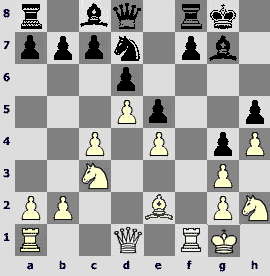
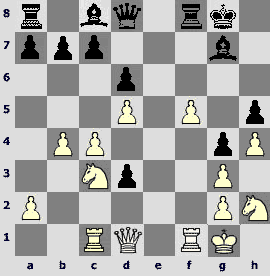
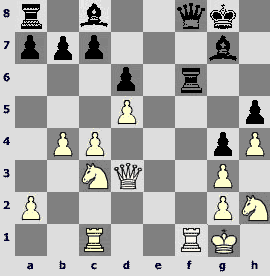

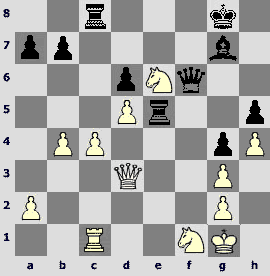
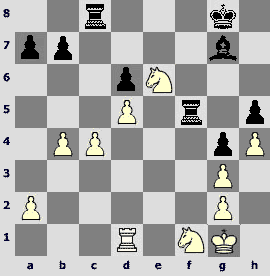

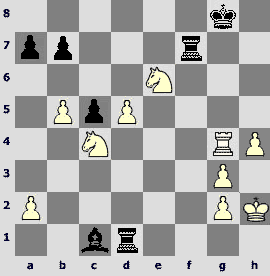
Moscow 1994 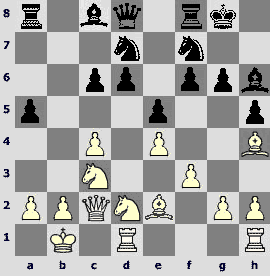
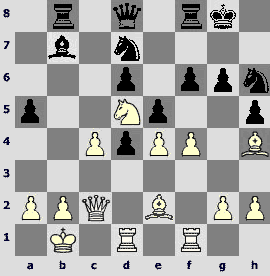
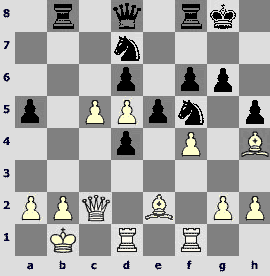


Dos Hermanas 1996 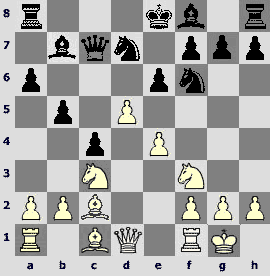
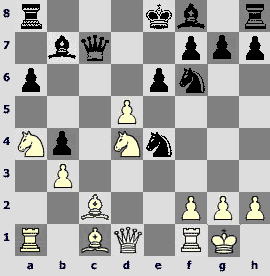
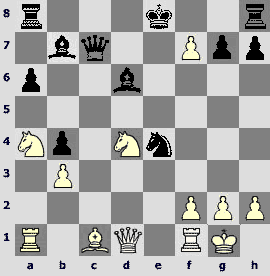


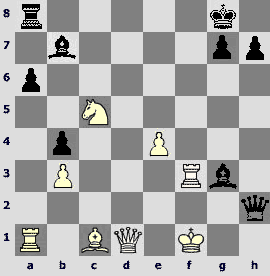
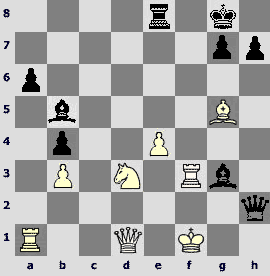
Novgorod 1997
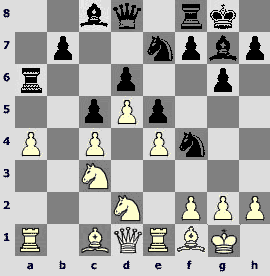
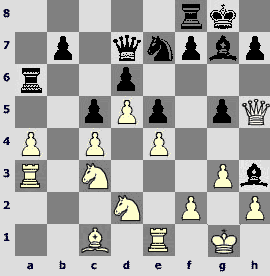
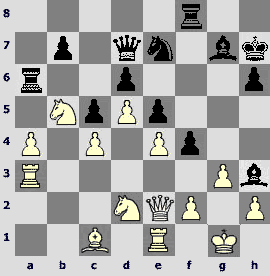
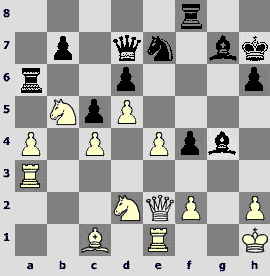
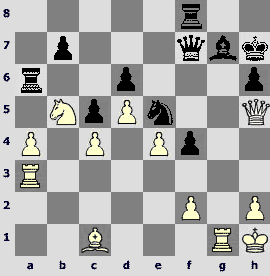

Linares 2000 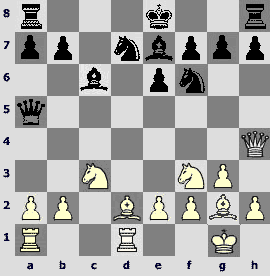
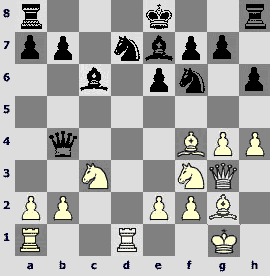
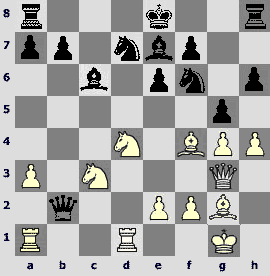
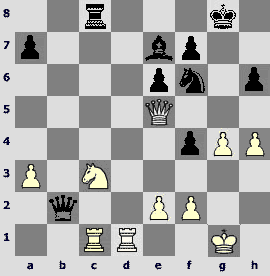
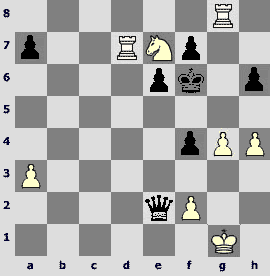
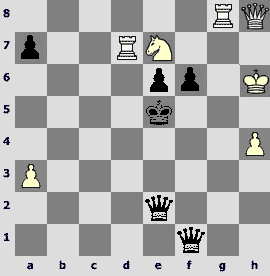
London 2000 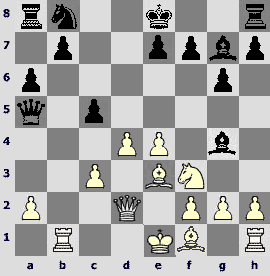
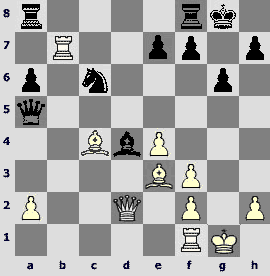
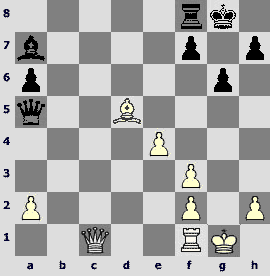
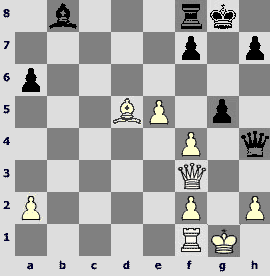

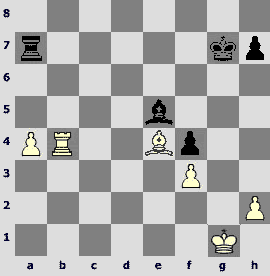
London 2000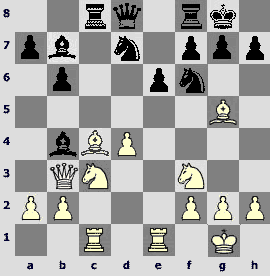
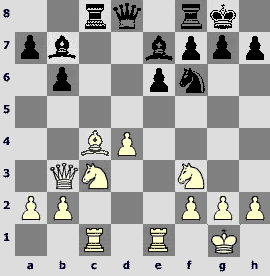
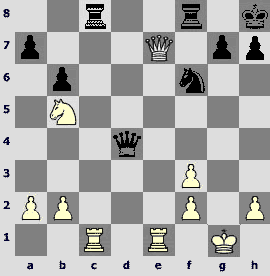
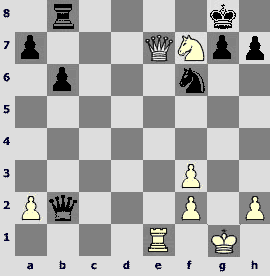
London 2000 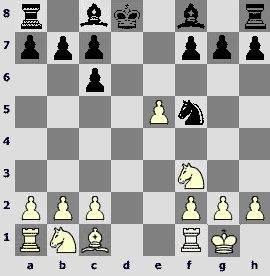
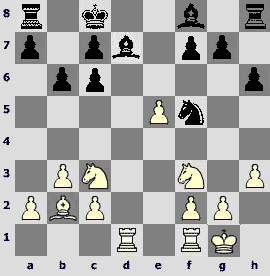
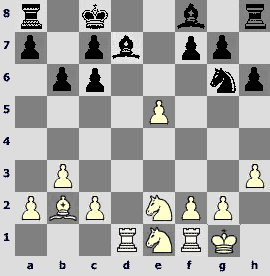
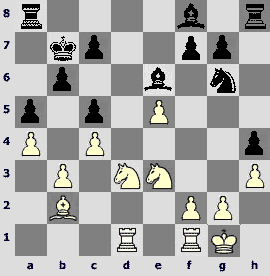
Brissago 2004 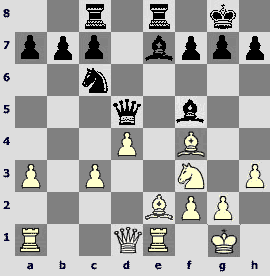

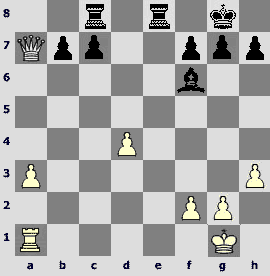

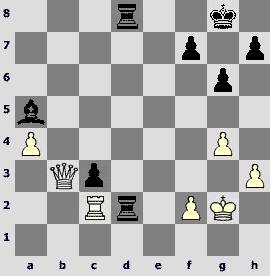
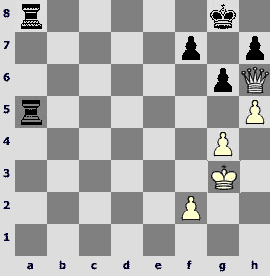
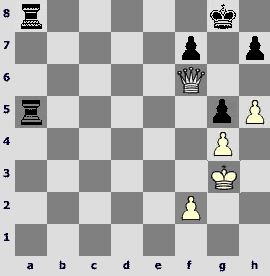
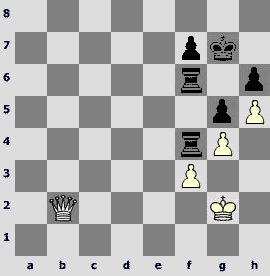
Brissago 2004 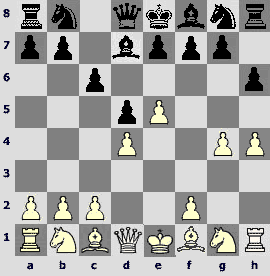
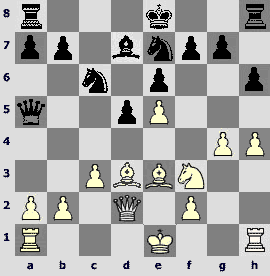
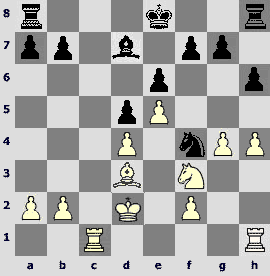
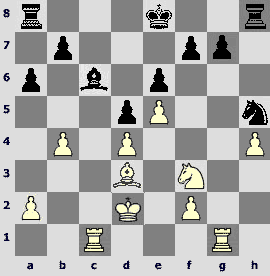
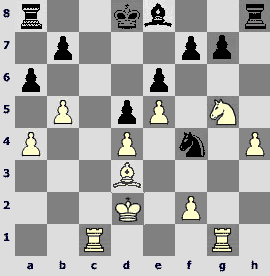
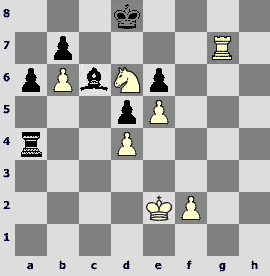
ALL ARTICLES BY AUTHOR

Discuss in forum